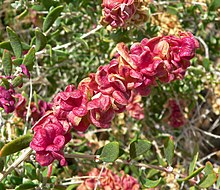Grayia (plant)
| Grayia | |
|---|---|
 |
|
| Grayia spinosa | |
| Scientific classification | |
| Kingdom: | Plantae |
| (unranked): | Angiosperms |
| (unranked): | Eudicots |
| (unranked): | Core eudicots |
| Order: | Caryophyllales |
| Family: | Amaranthaceae |
| Subfamily: | Chenopodioideae |
| Tribe: | Atripliceae |
| Genus: |
Grayia Hook. & Arn. |
| Synonyms | |
|
Zuckia Standl. |
|
Zuckia Standl.
Grayia is a genus of plants in the subfamily Chenopodioideae of family Amaranthaceae. Common names are siltbush and hopsage. The four shrubby species occur in arid and semiarid regions of western North America:
The species of Grayia are shrubs or subshrubs reaching 15–150 cm. The stems grow erect or ascending and are much branched and woody. Young stems are densely hairy, later glabrescent, lateral branches sometimes becoming spiny. Young branches are ribbed or striate. The old bark is gray brown. There are prominent subglobose buds in the leaf axils. The alternate leaves of 6–80 × 1.5–42 mm are succulent or coriaceous. They are nearly sessile or basally tapering to short petioles. The green to grayish leaf blades can be elliptic, ovate, obovate, spatulate, or linear-oblanceolate, with entire margins and prominent midveins. Espacially at the tips, the leaves are hariy with simple or branched hairs. The leaves have a "normal" (non-Kranz) anatomy.
The plants are dioecious or monoecious. The inflorescences consist of glomeruled male flowers arranged in interrupted axillary or terminal spikes or panicles, and of female flowers in terminal and axillary interrupted panicles. Male flowers are without bracteoles, comprising 4-5 membranous perianth lobes 1–1.8 mm long, connate to the middle, with hooded tips, and 4-5 stamens opposite to perianth lobes, inserted on a disc, with non-exserting anthers. The female flowers are sitting within 2 opposite bracteoles, a perianth is lacking, they consist just of an ovary with 2 filiform, exserted stigmas.
In fruit, the bracteoles enclosing the fruit become accrescent, folded along the midribs and connate nearly to the apex, 4–14 × 3–15 mm. Their shape can be orbicular, broadly elliptic, or cordate, their margins are usually entire, but sometimes wavy or extended into two wings, their surface is flat or ribbed, glabrous or hairy. Initially, bracteoles are yellowish-greenish or cream-colored, later they become reddish or pinkish. The orbicular, obovoid or laterally compressed-lenticular fruit (utricle) does not fall at maturity. The membranous pericarp is free or slightly adheres to the seed. The vertically or horizontally orientated seed has a brown to yellowish-brown, thin membranous seed coat. The annular embryo surrounds the copious farinaceous perisperm.
...
Wikipedia
